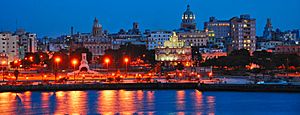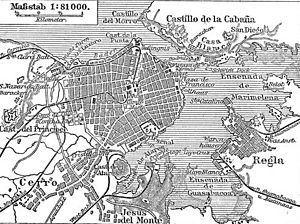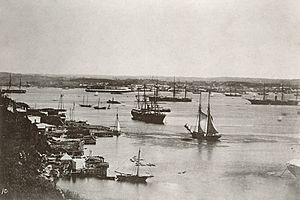Havana Harbor facts for kids
Havana Harbor is the main port in Cuba. It is located in Havana, the capital city. A port is a place where ships can load and unload goods or passengers. Besides Havana, other important port cities in Cuba are Cienfuegos, Matanzas, Manzanillo, and Santiago de Cuba.
The harbor was formed naturally by Havana Bay. Ships enter through a narrow opening. Inside, the bay splits into three main parts: Marimelena, Guanabacoa, and Atarés.
Contents
History of Havana Harbor

The Spanish built strong defenses around Havana Harbor in the 1500s. In 1553, they moved the governor's home to Havana from Santiago de Cuba. This made Havana the most important city on the island.
The Spanish knew how important these defenses were. English, French, and Dutch pirates and attackers tried to take the city in the 16th century. Later, in the 1700s, the Fortaleza de San Carlos de la Cabaña, also known as La Cabaña, was built. It is one of the largest fortresses in the Americas. It stands on a hill about 200 feet (60 meters) high, next to Morro Castle. On the western side of the harbor, in Old Havana, are two other old forts: Castillo de la Real Fuerza and San Salvador de la Punta Fortress. These were built in the 1500s.
In 1762, the British attacked Havana in what was called the Battle of Havana. They surrounded the harbor defenses for two months.
The USS Maine Incident
A very important event happened in Havana Harbor in 1898. The American battleship, the USS Maine, exploded and sank there. This event was a major reason for the start of the Spanish–American War.
In January 1898, the USS Maine was sent to Cuba. Its job was to protect American citizens living there. At that time, more than 8,000 Americans were in Cuba. Their safety was a concern because of the situation on the island. On February 15, 1898, the Maine exploded and sank. This tragedy became a rallying cry for the Spanish–American War. It led the United States to get involved in Cuba's fight for independence.
In 1912, the sunken ship was removed from the harbor. It was a danger to other ships. The wreck was then sunk in deep water in the Gulf of Mexico with a special military ceremony.
La Coubre Explosion
On March 4, 1960, a big explosion happened in the harbor. A French cargo ship called La Coubre was unloading 76 tons of weapons from Belgium. The blast killed about 100 people. The cause of the explosion is still debated.
First Recorded Shark Attack
Havana Harbor is known for having the first shark attack ever recorded. This happened in 1749 to a British sailor named Brook Watson.
Harbor Facilities
The harbor is divided into different areas, each with its own activities.
Marimelena Area
The town of Regla is in the Marimelena area. This part of the harbor is busy with businesses and factories. It has the Galainela shipyard, where ships are built or repaired. There is also the ENA drydock and the Navy's shipyard in Casablanca. Other important places here include the Havana Container Terminal (TCH), where large shipping containers are handled. There is also the Ñico Lopez oil refinery, which used to be a Shell refinery. Flour mills and fuel storage areas are also found here.
Guanabacoa Area
This part of the harbor is the least developed. It does not have as many businesses or activities as the other areas.
Atarés Area
The Atarés area is in Old Havana. This section has terminals for cruise ships, where tourists can get on and off. It also offers services for shipping and repairing vessels, run by a company called Asticar.
Environmental Concerns
Havana Bay is almost completely surrounded by shipping and industrial activities. This means the water in the bay is under a lot of stress from pollution. This pollution then flows into the Caribbean Sea, affecting its water quality too.
Water stays in the harbor for about 8 days on average before flowing out. The bay receives about 48,000 cubic meters of dirty water every day. This water carries a lot of nutrients like nitrogen and phosphorus, which can harm the environment. Havana Bay is heavily affected by sewage and also gets pollution from factories, farms, and port activities. This includes solid waste, oil, and heavy metals.
The main sources of pollution are the Luyano River, which carries organic material and sewage, and the Regla oil refinery. Fish farms and port activities also add to the pollution. The high levels of oil, heavy metals, and other pollutants are a big worry because the harbor is an important place for fishing.
See also
 In Spanish: Bahía de La Habana para niños
In Spanish: Bahía de La Habana para niños






